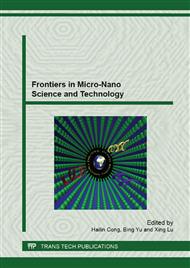[1]
C. Kriegel, A. Arrechi, K. Kit, D.J. McClements and J. Weiss, Critical reviews in food science and nutrition, 48, 775, (2008) 775-797.
DOI: 10.1080/10408390802241325
Google Scholar
[2]
W.E. Teo and S. Ramakrishna, Nanotechnology, 17, 89, (2006) 89-106.
Google Scholar
[3]
S. Ramakrishna, K. Fujihara, W. -E. Teo, T. Yong, Z. Ma and R. Ramaseshan, Materials Today, 9, 40, (2006) 40-50.
DOI: 10.1016/s1369-7021(06)71389-x
Google Scholar
[4]
Rocktotpal Konwarh, Karak Niranjan, Manjusri Misra, Biotechnology advances, 31, 4, (2013) 421-437.
Google Scholar
[5]
S.V. Guerra Nista, L. Peres, M.A. D'Avila, F.L. Schmidt and L.H. Innocentini Mei, Journal of Applied Polymer Science, 126 , 1, (2012) 70-78.
Google Scholar
[6]
D. Haas, S. Heinrich and P. Greil, Journal of Materials Science, 45, 5, (2010) 1299-1306.
Google Scholar
[7]
S. De Vrieze, T. Van Camp, A. Nelvig, B. Hagstrom, P. Westbroek and K. De Clerck, Journal of Materials Science, 44, 5, (2009) 1357-1362.
DOI: 10.1007/s10853-008-3010-6
Google Scholar
[8]
S.O. Han, J.H. Youk, K.D. Min, Y.O. Kang and W.H. Park, Materials Letters, 62, 4-5, (2008) 759-762.
Google Scholar
[9]
D. Klemm, B. Heublein, H. -P. Fink and A. Bohn, Angewandte Chemie International Edition, 44, 22, (2005) 3358-3393.
DOI: 10.1002/anie.200460587
Google Scholar
[10]
Kawasaki. T, Yoshikawa. M, Desalination and Water Treatment, 51, 25-27, (2013) 1-9.
Google Scholar
[11]
T.P.N. Nguyen, E. -T. Yun, I. -C. Kim and Y. -N. Kwon, J. Membr. Sci, 433, 49, (2013) 49-59.
Google Scholar
[12]
E. Butler, A. Silva, K. Horton, Z. Rom, M. Chwatko, A. Havasov and J.R. McCutcheon, Desalination, 312, 23, (2013) 23-30.
DOI: 10.1016/j.desal.2012.12.013
Google Scholar
[13]
P.B. Kajjari, L.S. Manjeshwar and T.M. Aminabhavi, Journal of Industrial and Engineering Chemistry, 50, 13, (2013).
Google Scholar
[14]
S.O. Han, W.K. Son, J.H. Youk, T.S. Lee and W.H. Park, Materials Letters, 59, 24-25, (2005) 2998-3001.
DOI: 10.1016/j.matlet.2005.05.003
Google Scholar
[15]
Y.I. Yoon, H.S. Moon, W.S. Lyoo, T.S. Lee and W.H. Park, Carbohydrate polymers, 75 , 2, (2009) 246-250.
Google Scholar


